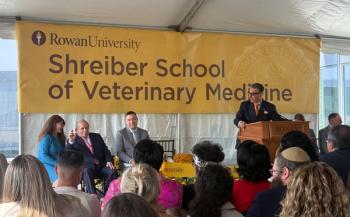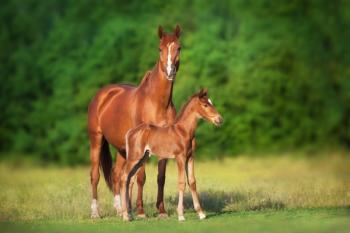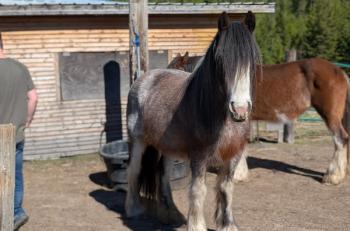
Equine leptospirosis (Proceedings)
Leptospirosis is caused by a highly invasive, spiral bacteria in the genus Leptospira.
Leptospirosis is caused by a highly invasive, spiral bacteria in the genus Leptospira. The infectious agent is capable of infecting man and animals. There is less known about leptospirosis in horses than any common domestic animal except the cat. The DNA-based genus classification of Leptospira includes 8 pathogenic species and 5 non-pathogenic species. Serovars, which are based upon the older phenotype classification, are sometimes classified as host adapted infection or incidental host infection. Host adapted strains seldom cause clinical disease in their maintenance host, infection and shedding are prolonged, and the serologic response following infection is relatively low. Conversely, incidental host serovars are more likely to cause clinical disease in a non-maintenance host, a marked serologic response occurs following infection, and there is only a brief period of shedding. In North American horses, Leptospira pomona kennewicki is the prominent incidental (pathologic) serovar and the skunk is the most common maintenance host of this serovar. In Europe, important equine strains are L. kirschneri, serovar gripphotyphosa, strains duster (western Europe) and moskva (eastern Europe). Leptospira bratislava is considered by most researchers to be the host adapted serovar of the horse. This belief is met with some controversy, as horses may have high equine serum titers to bratislava and some researchers believe bratislava is pathogenic in the horse.
Clinical Diseases
Pathogenic Leptospira infections in the horse appear to have organ trophism for either the reproductive tract of the female, kidney or eye. Infection may result in placentitis and abortion, acute renal failure, or hematuria and most importantly, uveitis.
Reproductive Tract Infection
Leptospira pomona abortions account for approximately 13% of bacterial abortions in mares in endemic regions. Serovar Pomona is responsible for most of the Leptospira abortions in North America, but Grippotyphosa and Harjo have also been reported. Most abortions are late term (> 9 months) and rarely a live foal may be born ill due to leptospirosis. Leptospira organisms are commonly found in the placenta, umbilical cord, and kidney and liver of the infected fetus. Pathology is present in the placenta, a placentitis not involving the cervical star. Macroscopic lesions are edema and areas of necrosis in the chorion. Microscopic lesions include necrosis and calcification of the placenta. Macroscopically, the liver may have a yellow discoloration. Liver disease is caused by a combination of multifocal necrosis and giant cell hepatopathy. Tubulonephrosis and interstitial nephritis may be present in the kidney of the aborted fetus. Inflammation of the umbilical cord, funisitis, may be recognized by a diffuse yellowish discoloration. It is unknown if the abortion occurs because of the placentitis, funiculitis or fetal infection, or all 3. Although more than 1 mare on a farm may abort due to Leptospira infection, it is rare for an epidemic of abortions to occur. Some mares that are infected do not abort. Aborting mares and other recently infected horses are believed to shed L. pomona in the urine for approximately 2-3 months. A small number of horses on the farm experiencing 1 or more Leptospira abortions may develop uveitis weeks later.
Acute renal Failure
Occasionally, L. pomona may cause fever and acute renal failure in the horse. The kidneys are swollen due to tubulointerstitial nephritis and the urine may have pyuria without visible bacteria. On rare occasion, multiple horses may be affected with fever and acute renal failure following Leptospira infection.
Recurrent Uveitis
The most important clinical disease associated with L. pomona infection in the adult horse is recurrent uveitis/keratitis. There appear to be two separate ocular diseases associated with L. pomona: the most common is Equine Recurrent Uveitis (ERU) and a more recently described disease is immune-mediated keratitis. The strong association between ERU and L. pomona dates back to the early 1950's with a general belief that it was an immune-mediated disease with antibody (IgG and IgA) against certain Leptospira antigens cross-reacting against equine uveal tissue, lens, cornea and possibly retina. Since 2000, there have been numerous scientific publications confirming live Leptospira in the uveal tissue, aqueous or vitreous fluid of horses with RU. High antibody concentration to L. pomona in the aqueous humour compared to serum titers also suggest persistent local antigenic stimulation. Survival of the organism in the face of high ocular antibody indicates an absence of cells/molecules, e.g., complement, involved in bacterial clearance, suggesting ocular immune privilege similar to the central nervous system. The recurrent episodes of the disease may be related to a Th1 response of autoreactivity following mimicry and inter- and/or intra-molecular epitope spreading. Genetic factors are likely involved in the disease process, helping to explain why only some horses infected with leptospira develop uveitis. Appaloosa are thought to be genetically predisposed. ERU is the most common cause of blindness in horses. Prevalence of ERU is unknown, but reports suggest 1-7.6% of horses will develop the disease. It is probable that some cases of ERU are not associated with Leptospira infection and this may vary by geographic region. A recent abstract from North Carolina could not confirm any relationship between active Leptospira infection and ERU; more research needs to be performed to further confirm or disprove a link between active Leptospira infection and ERU! In some regions, >50% of ERU cases have been shown to be associated with persistent ocular infections with Leptospira. Leptospira-associated uveitis may cause corneal, anterior chamber, and posterior chamber disease. Therefore, clinical findings may vary from corneal edema, clinically quiet retinal lesions observed on fundoscopic exam, and, most dramatically, recurrent and progressive painful uveitis. The chronic disease of the globe may cause cataracts, retinal degeneration, or even glaucoma.
Diagnosis
Diagnosis of Leptospira abortion is best accomplished by fluorescent antibody testing (FAT) or immunohistochemistry of the placenta, umbilical cord, or fetal liver and kidney. The sensitivity and specificity of the FAT on those tissues are nearly 100%. Examination of silver stained kidney samples in horses with renal disease does not have a high accuracy, as there may be false negative and false positive (likely due to non-pathogenic serovars). Marked increases in serum titers often accompany Leptospira abortions or acute renal failure, but may be low with recurrent uveitis because of the chronic localized infection. Acute L. pomona infections will often cause marked elevations in several serovars, but the non-infecting serovar titers will decline much more quickly over several weeks than the titers to the actual infecting serovar. Serovar specific FAT of a urine sample or dried urine sediment can be helpful in diagnosis and determination of continual shedding. Collection of the second voided urine sample following furosemide administration may improve sensitivity of this test. Serology, culture or PCR of aqueous fluid may be the only way to confirm Leptospira associated uveitis.
Treatments
Systemic administration of antibiotics would be indicated for horses with fever and acute renal failure caused by leptospirosis. Ticarcillin was used successfully in 1 horse with acute renal failure. Other antibiotics that Leptospira may be sensitive to include; penicillin, ampicillin, cephlosporins, enrofloxacin, tetracycline and doxycycline. Previous attempts to decrease urine shedding in horses with acute or subacute Leptospira infection by using oxytetracycline, penicillin G and streptomycin was not effective. Fluid therapy would be indicated as supportive treatment of acute renal failure.
There have been a variety of treatments for ERU, e.g., corticosteroids and cyclosporine, used in hopes of decreasing the inflammatory response, but these have generally provided only temporary relief and most affected horses either become blind or have the eye removed because of intractable and persistent pain. Vitrectomy with inoculation of a gentamicin lavage has been reported to be a successful treatment in Europe. The mounting evidence that active L. pomona infections are present in many of the horses with ERU helps explain our inability to cure most cases. If Leptospira is believed to be associated with a case of ERU, it seems prudent that an effort should be directed towards treating the possible chronic infection. Unfortunately, antibacterial treatment of ocular leptospirosis may not be easy since the blood ocular barrier inhibits movement of antimicrobials from the plasma into the eye. Even with inflammation, some interference may persist. In healthy ponies, doxycycline could not be found (limit of detection < 0.3 μg/ml) in the aqueous humour after 21 day treatment with 5 mg/kg q 12 hours. In recent in vitro work, enrofloxacin demonstrated low MIC and MBC (< 0.30 μg/ml) against strains of L. pomona. Peak aqueous levels of enrofloxacin are 0.32 ug/ml after repeated intravenous dosing with 7.5 mg/kg Baytril 100. Topical antibiotics may reach adequate levels in the aqueous but typically diffuse poorly into the vitreous.
Prevention
Acutely infected horses and/or mares aborting from Leptospira infection should be isolated for 14-16 weeks and/or the urine tested by FAT to determine if the mare is shedding. Limiting exposure to stagnant water and to potential maintenance host, e.g., skunk, may help in the control of leptospirosis. Vaccination (extra-label) against L. pomona is sometimes performed on farms with endemic abortions and/or a high rate of uveitis. A half dose of Gestafen® has been used in the horse without noted adverse effects and a serologic response was obtained, but protection was not evaluated. Vaccination of infected horses with a whole cell vaccine could theoretically cause ERU, although this has been rarely observed. An effective and safe leptospirosis vaccine, approved for the horse, would be a welcome addition to equine preventative medicine.
References
Sebastian M, et al. Vet Pathol 2005;42(5):659.
Rohrbach BW, et al. Vet Ophthalmol 20058(3):171.
Wada S, et al. Vet Ophthalmol 2003;6(3):191.
Lucchesi PM, et al. BMC Microbiol 2002;2:3.
Wollanke B, et al. J Am Vet Med Assoc 219(6):795.
Donahue JM, et al. Vet Clin North Am Equine Pract 2000;16(3):443.
Faber NA, et al. J Clin Microbiol 2000;38(7):2731.
Brem S, et al. Berl Munch Tierarztl Wochenschr 1999;112(10-11):390.
Bernard WV, et al. J Am Vet Med Assoc 1993;202(8):1285.
Divers TJ, et al. J Am Vet Med Assoc 1992;201(9):1391.
Palaniappan RU, et al. J Med Microbiol 2004;53(10):975.
Palaniappan RU, et al. Mol Cell Probes 2005;19(2):111.
Palaniappan RU, et al. Infect Immun 2002;70(11):5294.
Palaniappan, RU, et al. J Infect and Immun 2006;74(3):1745-1750.
Kim D , et al. J of Vet Sci 2006;7(4):355-359.
Szeredi L, et al. Vet Path 2006;43(5):755-761.
Newsletter
From exam room tips to practice management insights, get trusted veterinary news delivered straight to your inbox—subscribe to dvm360.






